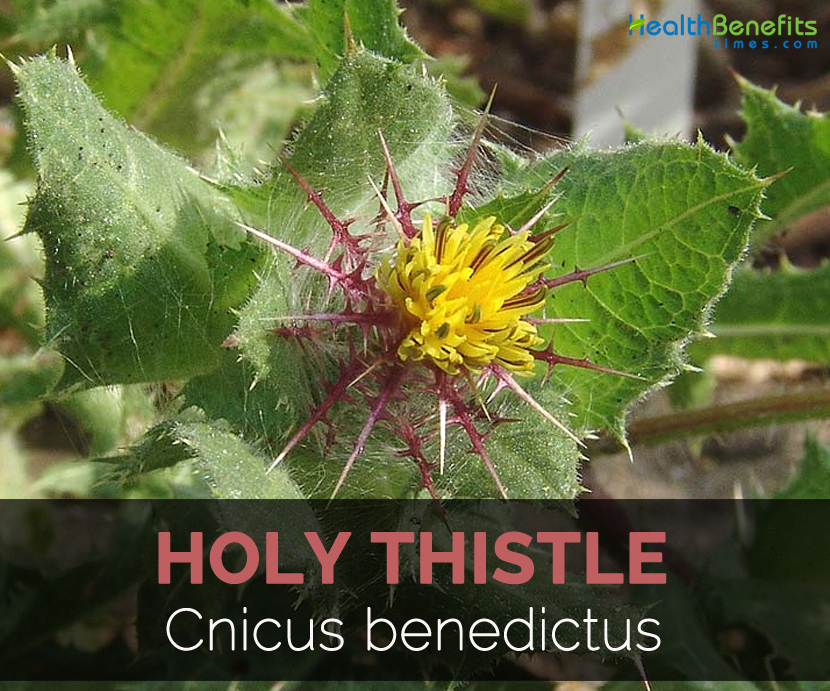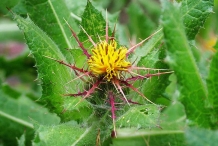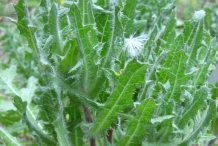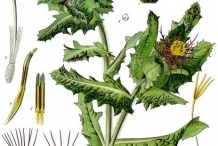| Holy Thistle Quick Facts |
| Name: |
Holy Thistle |
| Scientific Name: |
Cnicus benedictus |
| Origin |
Native to Mediterranean region (from Portugal North to Southern France and East to Iran). |
| Taste |
Strong, bitter |
| Health benefits |
Supports digestion, Liver health, Breastfeeding mothers, Menstrual problems, Skin health |
Holy thistle is highly reputed as cure all. Other names of Holy Thistle include St. Benedicts Thistle, Holy Thistle, Cardin, Spotted Thistle, Blessed thistle, Holy Ghost Herb and Cardo Santo. It got its latin name Cnicus Benedictus due to its ability to cure. This medicinal herb has been used for more than 2000 years for its medicinal uses. It belongs to Asteraceae family and is native to Mediterranean region, Europe, Western Asia and Eastern United States. It has constituents like iron, lignanas, manganese, potassium, magnesium, mucilage, cnicin, tannins and essential oil. It has medicinal properties such as tonic, digestive, febrifuge, emetic, diuretic, anti-inflammatory, stimulant, antidiarrheal and expectorant. Holy Thistle is known as an introduced species and noxious weed in other parts of the world.
It is available in form of capsules, tinctures and teas. It is useful for treating hormone imbalance and promotes circulation. This herb transport oxygen to brain. Holy thistle possess astringent compounds which are antiseptic, shrink inflamed tissue and dilate peripheral blood vessels. Being a great source of potassium, it is used for amenorrhea, dysmenorrhea, fevers, jaundice, dysura, arthritis and respiratory allergies.
History
During middle Ages in Europe, the plant was widely cultivated for its medicinal use which was mentioned in the Shakespeare’s play Much Ado about Nothing. It was used to treat plague, gout, headache, fever and digestive problems. The herb is regarded to be a galactogogue, emenagogue and abortifacient. The stems, flowers and dried leaves are also used for medicinal purposes. It is also used to flavor alcoholic beverages.
Plant
Holy Thistle is an annual plant that grows upto the height of 60 cm with 30 cm long, 8 cm broad hairy and leathery leaves. The yellow flowers are formed in a dense flowerhead which is surrounded by various spiny basal bracts. Flowers measures 3-4 cm in diameter.
Flower and Fruit
The plant bears a pale yellow and solitary flower. It has tubular florets but few lateral florets are sterile having 3 part borders. Outer bracts end in a simple thorn whereas inner bracts terminate in a long, pinnatifid and rigid thorn. It is broad and leafy connected to cordate to oblong leaflets. Fruit has tuft of hair.
Stem, leaves and root
It grows up to the height of 30-50 cm with heavily branched stems of thistle, glutinous and villous pubescent. It bears emarginated to pinnatifid, oblong leaves which are roughly reticulate and thorny-dentate.
Health Benefits of Holy Thistle
Holy Thistle is used to detoxify and purify the body and also assist in circulation of blood. It cleanses bacteria from blood, alleviate pain, strengthen immune system and eliminate unwanted fat. The plant is useful for treating liver problems and prevents it from damage. Holy Thistle is useful for coughs, diabetes, diarrhea, lungs, kidney, menopause, headaches, hepatitis, gallbladder and constipation. The roots, stem, leaves and blossoms are used in form of tonic beverage, tea and capsules from centuries. Listed below are some other health benefits:
- Supports digestion
Holy Thistle is a tonic for digestive problems. It is consumed in the form of tea before meal in order to prevent gas, indigestion and bloating. Since ancient times, it has been used to promote appetite. This herb possesses cholagogue properties that promotes bile production and also stimulates the production of gastric juice and saliva. Besides being aid for digestive system, it lowers the chances of gallstones and liver illness.
- Liver health
Holy Thistle assists in detoxification of body as well as liver. The lifestyle and diet factors put strain on livers. This herb is an ingredient which is used in various herbal formulas to cleanse liver. As it is able to stimulate bile production, it assist in detoxification of liver and other organs. It is also used for the treatment of jaundice.
- Breastfeeding mothers
Not all the women have sufficient amount of milk to feed their babies properly. Holy Thistle possesses emenagogue properties that enhance the quality as well as production of breast milk.
- Menstrual problems
Lot of women suffers from horrible symptoms during their menstrual cycle. The evidence shows that Holy thistle assist in alleviation of these monthly symptoms such as brain fog, headaches and other cramps.
- Skin health
Holy Thistle herb possesses anti-inflammatory, antimicrobial properties that are beneficial for the skin. It has antioxidants that maintain the skin look young and fresh. The astringent property tightens the skin. Apply it in form of poultice for treating minor cuts, wounds, grazes and also prevent infections.
- Lower inflammation
Holy Thistle possesses anti-inflammatory properties that help to lower the chances of heart disease, cancer and dementia as inflammation is at heart of these illnesses.
- Eliminate bacteria and microbes
Holy Thistle is able to counteract harmful bacteria and microbes. Its antibacterial properties are due to the presence of two compounds such as cnicin and polyacetalyne. The research has shown that these chemical compounds effectively treat Bacillus subtilis, Staphylococcus aureus and E.Coli.
- Acts as a diuretic
Diuretic helps to stimulate the production of urine and promote the frequency and flow of urination. The diuretic medication has been prescribed for kidney problems and infections of urinary tract. Holy Thistle is a natural diuretic which can be used as an alternative for powerful pharmaceutical medications.
Traditional uses
- Holy Thistle is useful for flatulent dyspepsia, anorexia and bronchial catarrh.
- It is applied topically for indolent and gangrenous ulcers, enteropathy and atonic dyspepsia.
- The herb is used as cholagogue.
- Use it internally in case of fever, loss of appetite, colds and anorexia.
- It is used externally for ulcers and wounds.
- Algerian uses the roots to cure wounds and burns.
- In Middle ages, it was used to cure plague.
- It promotes the milk supply in nursing women.
- The herb is used to treat gall bladder and liver problems.
- It is used internally to treat poor appetite, anorexia, dyspepsia, flatulent colic etc.
- It strengthen emotions and also useful for agitation, melancholy and nervous disorders.
Precautions
- An individual who are hypersensitive to the members of Compositae such as ragwort, chamomile and tansy might get allergic reactions.
- Avoid excessive use by lactation and pregnant women.
- More than 5 gram per cup of tea, it causes vomiting and stomach irritation.
- The people with heartburn and gastric ulcers should use it with caution because it increases stomach acid secretion.
- If used with blood thinning agents and anticoagulants, it increases bleeding.
- Not recommended to use by the people having Chron’s disease, intestinal problems and inflammatory conditions because it might irritate intestines and stomach.
- Consult the health practitioner for use.
- It may cause side effects such as tightness in throat, chest, breathing problems, chest pain, swollen skin, itching, rash and skin hives.
- No information of safety regarding use by the children.
How to Eat
- It is consumed as a green leaf with butter and bread.
- The plant is ingested in form of tea.
References:
https://www.itis.gov/servlet/SingleRpt/SingleRpt?search_topic=TSN&search_value=510524#null
http://davesgarden.com/guides/pf/go/32193/
https://npgsweb.ars-grin.gov/gringlobal/taxonomydetail.aspx?id=10967
http://www.pfaf.org/user/Plant.aspx?LatinName=Cnicus+benedictus
http://www.floracatalana.net/cnicus-benedictus-l-
https://www.drugs.com/npp/blessed-thistle.html
https://medlineplus.gov/druginfo/natural/94.html
https://wellnessmama.com/375/blessed-thistle/
https://www.allinahealth.org/CCS/doc/Thomson%20Alternative%20Medicine/48/10095.htm
https://en.wikipedia.org/wiki/Cnicus
http://www.bellybytes.com/herbs/blessed-thistle.html#.WcijhLIjH3h
https://healthyfocus.org/8-benefits-of-blessed-thistle/
Comments
comments





